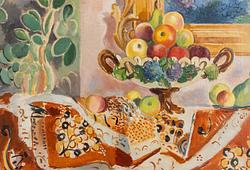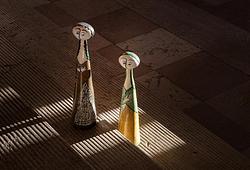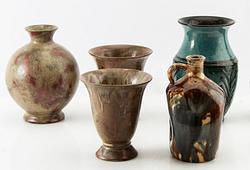Leander Engström
"Parken"
Signed Leander Engström and dated Roma 1921. Canvas 61.5 x 46 cm.
Provenance
Previously in Doctor Gustaf Hedberg's collection.
Literature
Nils Palmgren, "Leander Engström", 1939. Illustrated p. 91.
More information
Leander Engström holds a unique position in Swedish art history as one of the most colorful and passionate expressionists of the early 20th century.
Born in Ytterhogdal in the region of Härjedalen and raised in the landscapes of northern Sweden, Engström carried with him a deep sense of nature’s grandeur and drama—something that would become a fundamental theme in his artistic work. He studied at the Konstnärsförbundet School in Stockholm and later traveled to Paris, where in 1911 he met the circle of Swedish artists surrounding Matisse. There he discovered the expressive possibilities of color—an encounter that would profoundly shape his vision.
Back in Sweden, Engström became one of the key figures in the younger generation of artists who exhibited at the legendary De Unga exhibition in 1909 and later at the Expressionist Exhibition in 1918.
He is especially known for his motifs from Tornedalen in the far north of Sweden, where he found an inexhaustible source of inspiration. The northern mountains, the Sámi people, reindeer herding, and the shifting arctic light are all depicted in works that pulse with life and presence. At the same time, Engström traveled frequently—to Italy, France, and Spain—and these journeys introduced new dimensions to his art: variations of light, urban scenes, architecture, and diverse cultural impressions.
His 1921 painting Two Girls by a Fountain, created in Rome, is a clear example of his ability to merge Nordic temperament with Southern European light and atmosphere.
Artist
Per leander Engström was a Swedish visual artist born in Ytterhogdal. He studied under the tutorship of Henri Matisse in Paris and the artists association school in Stockholm. Engström was part of the artistic group De Unga together with none other than Isaac Grünewald and Tor Bjurström. Engström was greatly inspired by Paul Gauguin, Vincent van Gogh and Paul Cézanne. Leander Engström followed in Osslund's footsteps and was captivated by Lapland's overwhelming natural scenery, which he depicted using the forms and colors of Fauvism. His paintings from 1912-15 - landscapes, still lifes, nude scenes - are harmonious and emotional, built upon Cézannes principles of discrete, weak colours. The years between 1916 and 1919 kan be understood as his most expressionistic period. Sweeping lines, large stylised planes and bright strong colours dominated his characteristic style. Engström found himself in Italy between 1920 and 1922 where he studied the early Rennaissance; it was during this time that he neared new objectivity. Leander Engström was one of Matisse's most impressive pupils.
Read more














































